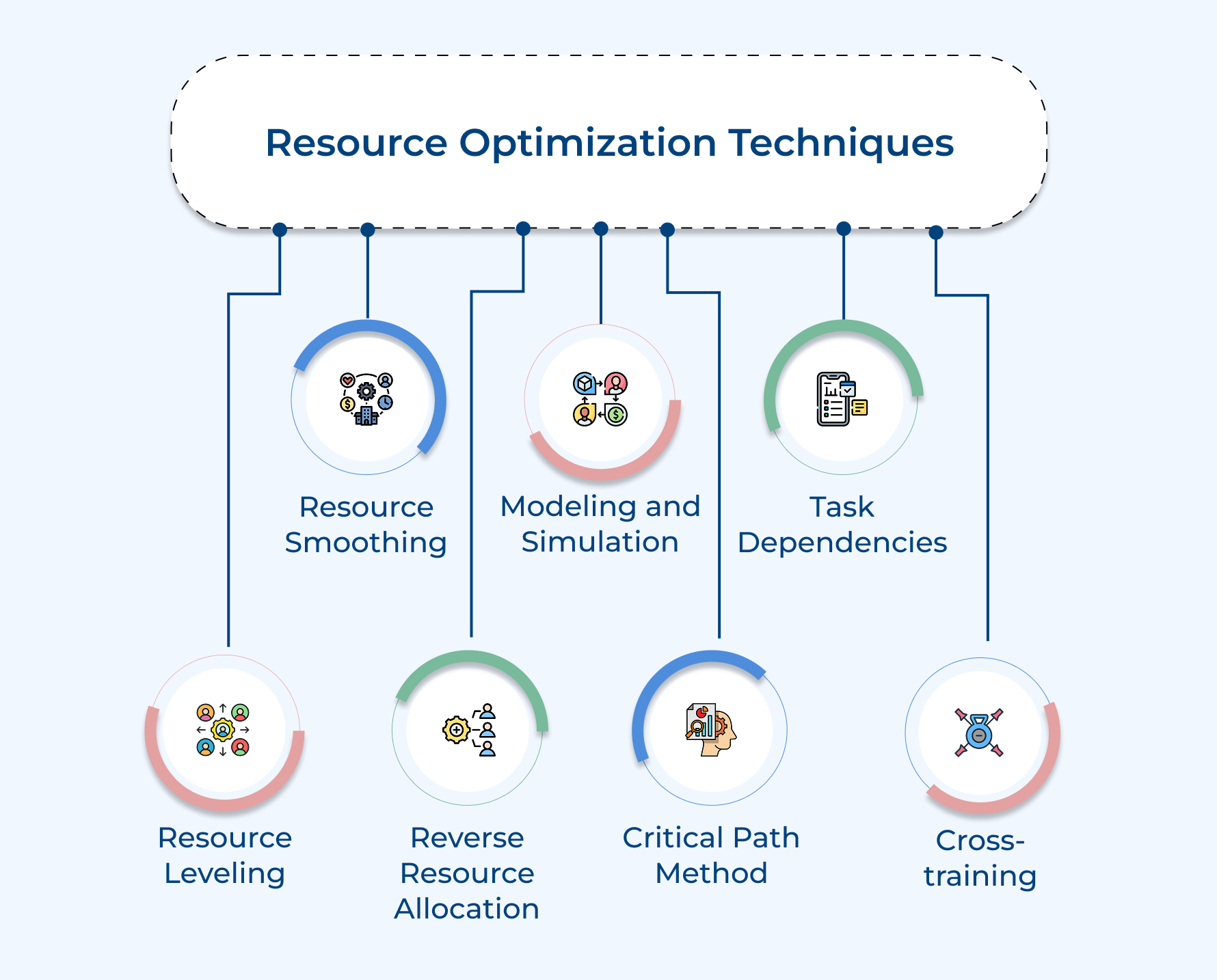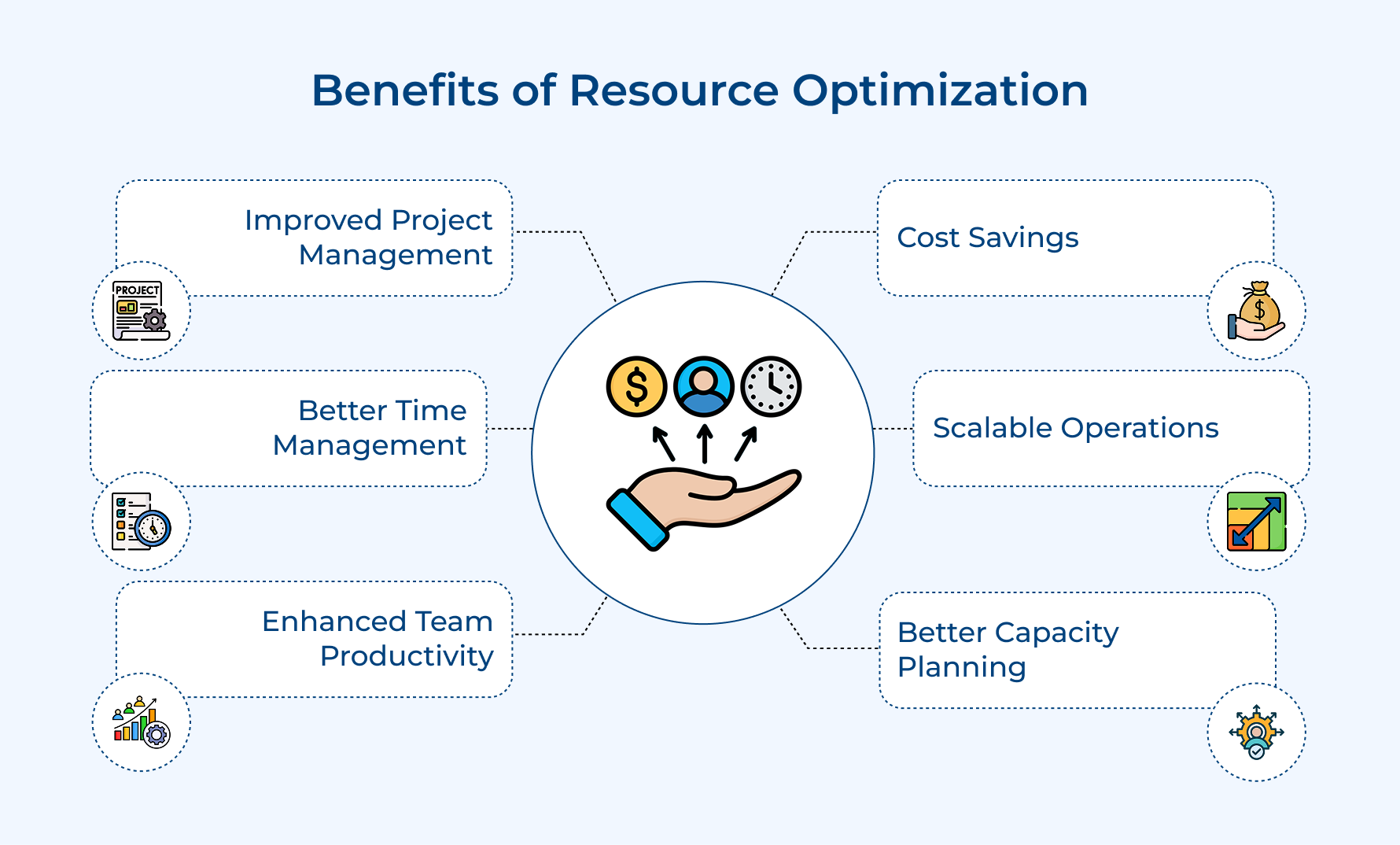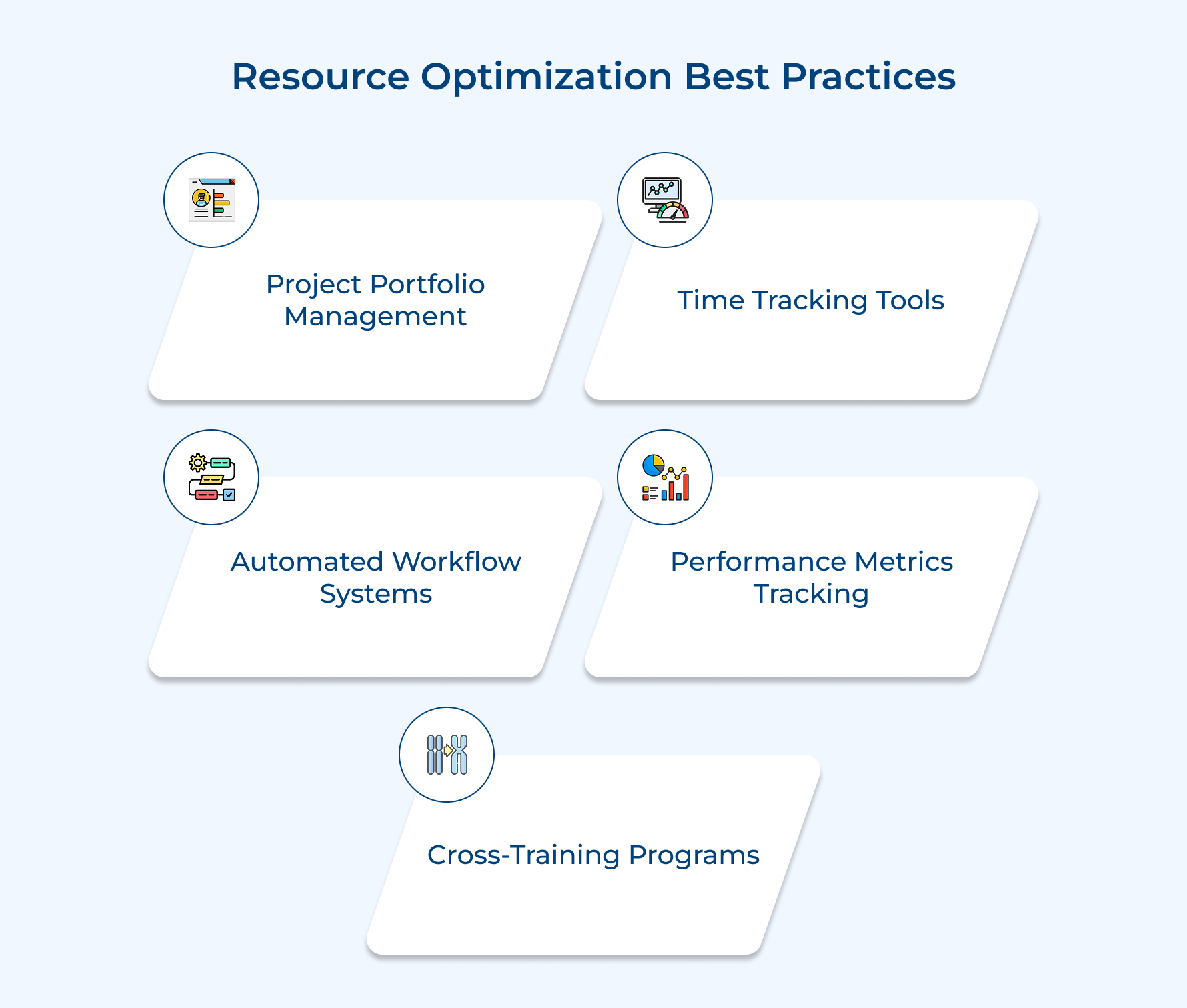What is Resource Optimization? Guide for Maximum Efficiency
- What is Resource Optimization?
- What are the Different Resource Optimization Techniques?
- Benefits of Resource Optimization
- Challenges of Resource Optimization and How to Fix Them
- Resource Optimization Best Practices
- Driving Productivity and Profitability with Resource Optimization
- FAQs about Resource Optimization

Key Highlights:
- Resource optimization helps businesses maximize output, reduce waste, and ensure efficient use of time, talent, and technology.
- Streamlined workflows and effective capacity planning lead to better project outcomes as well as improved team productivity for any organization.
- Cross-training and flexible resource allocation empower teams to adapt quickly to changing project demands.
Are you making the most of your resources? Inefficiencies and wasted resources can drain a business, leading to higher costs as well as missed opportunities.
Without a solid strategy for managing time, talent, and technology, companies struggle with reduced productivity along with rising expenses. Hence, making it harder to stay competitive.
Resource optimization like allocation, automating repetitive tasks, and streamlining processes, are a few efficient ways for businesses to drive sustainable growth. Let’s explore smart strategies to optimize your resources and achieve better results.
What is Resource Optimization?
Resource optimization refers to the process of effectively and efficiently using available resources (such as human capital, time, equipment, and finances) to achieve business goals. The aim is to maximize the output of available resources while minimizing waste, redundancy, and inefficiencies. It involves careful planning, monitoring, and adjusting resource allocation to ensure that each asset is utilized to its full potential.
Proper optimization allows businesses to make the most of limited resources, ensuring that they can meet their objectives while maintaining a lean operation. Without resource optimization, companies risk overburdening certain assets while underutilizing others, leading to inefficiencies and increased operational costs.
Key objectives:
- Maximize output: Ensure the highest possible output with the least amount of input, using resources efficiently to achieve business goals.
- Reduce waste: Minimize resource wastage through careful planning, streamlining processes, and eliminating unnecessary expenditures.
- Improve productivity: Enhance productivity by aligning the right resources with the right tasks at the right time.
What are the Different Resource Optimization Techniques?
Struggling with wasted time, high costs, or underused talent? Let’s explore smart resource optimization techniques to boost efficiency and drive growth!
1. Resource Leveling
Ever felt like your team is drowning in work one week and twiddling their thumbs the next? That’s where resource leveling comes in!
This technique helps adjust project timelines based on resource availability, ensuring workloads stay balanced. No more burnout during peak times or wasted potential during slow periods—just steady, efficient progress.
Project managers can tweak schedules, delay non-urgent tasks, or shift work around to keep everything running smoothly by analyzing resource demands. The result? A productive team, better project outcomes, and a healthier work environment.
Actionable tips:
- Create a master project calendar with resource allocation views to identify and address periods of over/under-utilization early.
- Implement weekly capacity planning meetings to review and adjust resource assignments based on current project demands as well as team availability.
2. Resource Smoothing
Want to streamline workloads and hit deadlines without chaos? Resource smoothing might be the perfect solution!
It keeps your project timeline intact while optimizing resource allocation. Unlike resource leveling, which adjusts deadlines, resource smoothing works within fixed schedules to balance workloads and avoid resource conflicts.
For professional service firms juggling multiple client deadlines, it ensures steady staffing levels and consistent delivery quality. By redistributing work within available float time—without touching critical tasks—you can prevent bottlenecks while keeping projects on track.
Pro tips:
- Use project management software to identify tasks with float time that can be rescheduled without impacting deadlines.
- Develop flexible team structures where resources can be shared across projects during peak periods.
3. Reverse Resource Allocation
Imagine an agency working on a big website launch set for June 30. Instead of guessing resource needs along the way, they start with the completion date and work backward. By mapping out key milestones and required resources at each stage, they ensure the right people are available at the right time.
The reverse resource allocation approach helps identify potential gaps early, allowing for proactive planning and securing additional resources if needed. The result? Smoother workflows, fewer last-minute scrambles, and projects that hit their completion dates without chaos.
Tips to consider:
- Create detailed resource requirement templates for different project types to streamline backward planning.
- Establish buffer periods in the timeline to account for unexpected resource constraints or scope changes.
4. Modeling and Simulation
Using data-driven models and simulations to predict resource requirements, test different allocation scenarios as well as identify potential bottlenecks before they occur in real projects.
Professional services firms need to make informed decisions about resource allocation. Modeling helps predict outcomes of different resource strategies and minimize risks associated with resource planning.
Utilize specialized software to create models based on historical project data, then run various scenarios to determine optimal resource allocation strategies for different project types.
Actionable tips:
- Build a database of past project metrics to improve the accuracy of future resource modeling.
- Run monthly simulation exercises to test resource allocation plans against various risk scenarios.
5. Critical Path Method (CPM)
Critical Path Method (CPM) ensures projects stay on schedule by identifying the longest sequence of dependent tasks.
For agencies handling time-sensitive deliverables, CPM highlights which tasks need immediate attention while allowing flexibility for less urgent ones. Mapping out all tasks, dependencies, and durations helps pinpoint the critical path, ensuring key milestones are met.
The structured approach minimizes risks, improves efficiency, and ensures smooth project execution from start to finish.
Pro tips:
- Create visual critical path diagrams for all major projects and update them weekly.
- Establish fast-track procedures for reallocating resources when critical path activities fall behind schedule.
6. Task Dependencies
Task dependency management ensures a seamless workflow by mapping out how different tasks connect and depend on shared resources.
In professional services, projects often involve complex interdependencies. Understanding these connections ensures smooth transitions between tasks and keeps everything on schedule. By creating detailed task dependency maps, teams can identify resource needs at each stage and plan accordingly.
Proper scheduling and resource alignment reduce delays, improve efficiency, and keep projects moving forward without unnecessary roadblocks.
Action tips:
- Develop standardized dependency templates for common project types to streamline planning.
- Implement weekly dependency reviews to identify and address potential resource conflicts early.
7. Cross-Training
A strategic approach to developing team members’ skills across multiple areas, creating a more flexible workforce that can handle various project requirements and responsibilities.
Agencies need adaptable teams that can respond to changing project demands. Cross-training ensures resource availability during peak periods and reduces dependency on specific team members.
Implement structured training programs where team members learn skills from different disciplines, creating backup resources for critical roles and enabling more flexible resource allocation.
Tips to consider:
- Create skill development matrices to track cross-training progress and identify training priorities.
- Schedule regular knowledge-sharing sessions where experts train colleagues in their specialty areas.
Benefits of Resource Optimization
Optimizing resources isn’t just about cutting costs—it’s about maximizing efficiency, reducing waste, and improving project outcomes. Let’s explore the key benefits.
Improved Project Management
Juggling multiple projects becomes easier with smart resource allocation. By prioritizing tasks and distributing work efficiently, teams can meet deadlines, avoid delays, and keep clients happy.
Better Time Management
When resources are planned effectively, teams can focus on high-priority tasks instead of wasting time on low-impact work. Streamlined workflows mean more time for revenue-generating activities.
Enhanced Team Productivity
Matching tasks to team members’ strengths and availability boosts efficiency while preventing burnout. Having everyone work at their best helps operations run smoothly and productivity soars.
Cost Savings
Reducing wasted time, talent, and equipment leads to significant cost savings. Smart resource allocation prevents overstaffing, unnecessary expenses, and underutilized assets.
Scalable Operations
With optimized resources, businesses can handle growth without stress. Whether scaling up services or managing increased client demands, efficiency remains high without sacrificing quality.
Better Capacity Planning
Accurate forecasting helps teams make informed decisions on hiring, training, and project timelines. This prevents resource shortages or excesses, ensuring smooth execution and long-term success.
Challenges of Resource Optimization and How to Fix Them
Optimizing resources comes with its own set of challenges, from overallocation to forecasting errors. Here’s how to tackle these issues and keep operations running smoothly!
Resource Underutilization and Overallocation
Team members are either sitting idle or overwhelmed with work, creating inefficiencies and burnout risks.
To address this, implement real-time resource tracking systems and establish utilization benchmarks (typically 75-85%). Use resource leveling techniques to redistribute work evenly and maintain a flexible talent pool, including freelancers to handle workload fluctuations. Regular capacity planning meetings can help anticipate and prevent these imbalances.
Budget Constraints
Limited budgets restrict optimal resource allocation and capability development.
Implement value-based pricing models, regularly review resource costs versus revenue generation, and optimize the resource mix between permanent as well as flexible staff. Develop strategic partnerships with contractors and freelancers to access specialized skills cost-effectively when needed.
Poor Project Estimation
Inaccurate time and resource estimates lead to project delays as well as budget overruns.
Solve this by analyzing historical project data to create more accurate estimates. Implement a standardized estimation process using tools like three-point estimation and PERT analysis. Regular post-project reviews help identify estimation patterns and improve future planning. Also, build contingency buffers for complex or high-risk projects.
Lack of Visibility and Communication
Limited visibility into resource availability and project demands causes scheduling conflicts along with inefficient allocation.
Address this by implementing integrated project management tools that provide real-time visibility into resource schedules and capacity. Establish regular resource planning meetings and maintain centralized project dashboards while creating clear communication channels between project managers as well as resource coordinators.
Project Dependencies and Scheduling Conflicts
Complex dependencies between tasks and projects create scheduling challenges.
Mitigate this by using critical path analysis and dependency mapping tools to identify potential conflicts early. Implement buffer times between dependent tasks, maintain flexible resource pools, and use resource smoothing techniques to optimize scheduling while maintaining project timelines.
Scope Creep and Changing Requirements
Evolving project requirements and unexpected client demands disrupt resource planning.
Combat this by implementing robust scope management processes, including clear change control procedures and impact assessments. Set realistic client expectations upfront, document all scope changes, and maintain resource buffers for handling unexpected changes without disrupting other projects.
Resource Optimization Best Practices
Maximizing efficiency starts with the right strategies. Here are the best practices to optimize resources and keep your projects on track!
Project Portfolio Management
Keep a clear, centralized view of all current and upcoming projects to distribute resources effectively. Regular portfolio reviews help spot conflicts early, allowing for proactive adjustments and smoother workflows.
Time Tracking and Analytics
Use time-tracking tools to monitor billable hours, project progress, and resource usage. Analyzing the data helps identify inefficiencies, improve billing accuracy, as well as refine future resource planning.
Automated Workflow Systems
Leverage automation for routine tasks to reduce manual workload and errors. It frees up professional staff to focus on high-value client work along with strategic initiatives.
Performance Metrics Tracking
Track key productivity and quality metrics to ensure resources are used effectively. Regular performance reviews help fine-tune resource allocation and drive continuous improvement.
Cross-Training Programs
Invest in cross-training to build team flexibility and create backups for critical roles. These programs reduce reliance on specific individuals while keeping projects moving smoothly, even during staff changes.
Driving Productivity and Profitability with Resource Optimization
Resource optimization plays a crucial role in maximizing efficiency, and reducing costs while boosting productivity for agencies as well as professional firms. Effective planning and monitoring ensure that all resources are allocated in the most efficient way possible, minimizing waste as well as improving overall performance.
Automating routine tasks also contributes to better resource utilization. With tasks like scheduling and reporting streamlined, teams can focus on high-value work, resulting in improved decision-making and productivity across the organization.
Resource optimization positions businesses for sustainable growth, ensuring long-term profitability and a strong competitive edge in the industry.
Limit time — not creativity
Everything you need for customer support, marketing & sales.
Neeti Singh is a passionate content writer at Kooper, where he transforms complex concepts into clear, engaging and actionable content. With a keen eye for detail and a love for technology, Tushar Joshi crafts blog posts, guides and articles that help readers navigate the fast-evolving world of software solutions.


